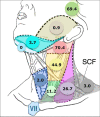Patterns of regional lymph node metastasis of nasopharyngeal carcinoma: a meta-analysis of clinical evidence
- PMID: 22433671
- PMCID: PMC3353248
- DOI: 10.1186/1471-2407-12-98
Patterns of regional lymph node metastasis of nasopharyngeal carcinoma: a meta-analysis of clinical evidence
Abstract
Background: The characteristics of cervical lymphatic metastasis in nasopharyngeal carcinoma (NPC) are not completely understood. As such, radiotherapy to the entire lymphatic of the neck bilaterally has been empirically practiced even in early stage disease, although not supported by clinical evidence. We studied the pattern and probability of nodal metastasis through a meta-analysis of published evidences, with an aim to establish an evidence-based guideline for selecting and delineation of clinical target volume of neck lymphatics for conformation radiation for NPC.
Methods: A literature search yielded an initial 411 original articles, and 13 studies with 2920 NPC cases staged via MRI were included in this analysis. The occurrence of nodal metastasis was calculated and analyzed according to the respective regional nodal levels.
Results: 85% of NPC cases presented with lymphadenopathy. The most commonly involved regions include retropharyngeal (69%) and level II lymph nodes (70%). The overall probability of levels III, IV, and V nodal involvement are 45%, 11%, and 27%, respectively. Low-risk node groups included the supraclavicular, levels IA/IB and VI nodes, and parotid nodes with involvement rates at 3%, 0%, 3%, 0%, and 1%, respectively. Nodal metastases followed an orderly pattern and the probability of "skip" metastasis between levels varied between 0.5-7.9%.
Conclusions: Lymph node metastasis in NPC follows a predictable and orderly pattern. The rarity of metastasis in certain nodal groups and "skip" metastasis suggest that reduced treatment volume is feasible in conformal radiotherapy for NPC.
Figures














Similar articles
-
[Magnetic resonance imaging analysis of regional lymph node metastasis in 1 298 cases of nasopharyngeal carcinoma].Lin Chuang Er Bi Yan Hou Tou Jing Wai Ke Za Zhi. 2012 Sep;26(18):769-72. Lin Chuang Er Bi Yan Hou Tou Jing Wai Ke Za Zhi. 2012. PMID: 23259286 Chinese.
-
[Regulation for distribution of metastatic cervical lymph nodes of 512 cases of nasopharyngeal carcinoma].Ai Zheng. 2004 Nov;23(11 Suppl):1523-7. Ai Zheng. 2004. PMID: 15566672 Chinese.
-
The feasibility analysis of omission of elective irradiation to level IB lymph nodes in low-risk nasopharyngeal carcinoma based on the 2013 updated consensus guideline for neck nodal levels.Radiat Oncol. 2017 Aug 18;12(1):137. doi: 10.1186/s13014-017-0869-x. Radiat Oncol. 2017. PMID: 28821277 Free PMC article.
-
Assessment of the Rate of Skip Metastasis to Neck Level IV in Patients With Clinically Node-Negative Neck Oral Cavity Squamous Cell Carcinoma: A Systematic Review and Meta-analysis.JAMA Otolaryngol Head Neck Surg. 2019 Jun 1;145(6):542-548. doi: 10.1001/jamaoto.2019.0784. JAMA Otolaryngol Head Neck Surg. 2019. PMID: 31070693 Free PMC article.
-
Metastatic retropharyngeal lymph nodes in nasopharyngeal carcinoma: imaging criteria.Expert Rev Anticancer Ther. 2010 Nov;10(11):1703-6. doi: 10.1586/era.10.159. Expert Rev Anticancer Ther. 2010. PMID: 21080798 Review.
Cited by
-
Role of Contrast-Enhanced Ultrasound (CEUS) in the Diagnosis of Cervical Lymph Node Metastasis in Nasopharyngeal Carcinoma (NPC) Patients.Front Oncol. 2020 Jul 17;10:972. doi: 10.3389/fonc.2020.00972. eCollection 2020. Front Oncol. 2020. PMID: 32766127 Free PMC article.
-
PEDF inhibits lymphatic metastasis of nasopharyngeal carcinoma as a new lymphangiogenesis inhibitor.Cell Death Dis. 2021 Mar 17;12(4):295. doi: 10.1038/s41419-021-03583-1. Cell Death Dis. 2021. PMID: 33731707 Free PMC article.
-
Baseline MRI-Radiomics Can Predict Overall Survival in Non-Endemic EBV-Related Nasopharyngeal Carcinoma Patients.Cancers (Basel). 2020 Oct 13;12(10):2958. doi: 10.3390/cancers12102958. Cancers (Basel). 2020. PMID: 33066161 Free PMC article.
-
Lower-Neck Sparing Using Proton Therapy in Patients with Uninvolved Neck Nasopharyngeal Carcinoma: Is It Safe?J Clin Med. 2022 Jun 9;11(12):3297. doi: 10.3390/jcm11123297. J Clin Med. 2022. PMID: 35743368 Free PMC article.
-
Diagnostic Value of Dynamic 18F-Fluorodeoxyglucose Positron Emission Tomography-Computed Tomography (18F-FDG PET-CT) in Cervical Lymph Node Metastasis of Nasopharyngeal Cancer.Diagnostics (Basel). 2023 Jul 29;13(15):2530. doi: 10.3390/diagnostics13152530. Diagnostics (Basel). 2023. PMID: 37568893 Free PMC article.
References
-
- Parkin WS DM, Ferlay RL J, Young J. Cancer Incidence in Five Continents, Vol 7. Vol. 7. Lyon: IARC Press; 1997.
-
- CA P. Principles and Practice of Radiation Oncolog. 3. Philadelphia: JB Lippincott; 1998. Nasopharynx.
-
- Lee AW, Ng WT, Hung WM, Choi CW, Tung R, Ling YH, Cheng PT, Yau TK, Chang AT, Leung SK. et al.Major late toxicities after conformal radiotherapy for nasopharyngeal carcinoma-patient- and treatment-related risk factors. Int J Radiat Oncol Biol Phys. 2009;73(4):1121–1128. doi: 10.1016/j.ijrobp.2008.05.023. - DOI - PubMed
Publication types
MeSH terms
LinkOut - more resources
Full Text Sources
Research Materials

